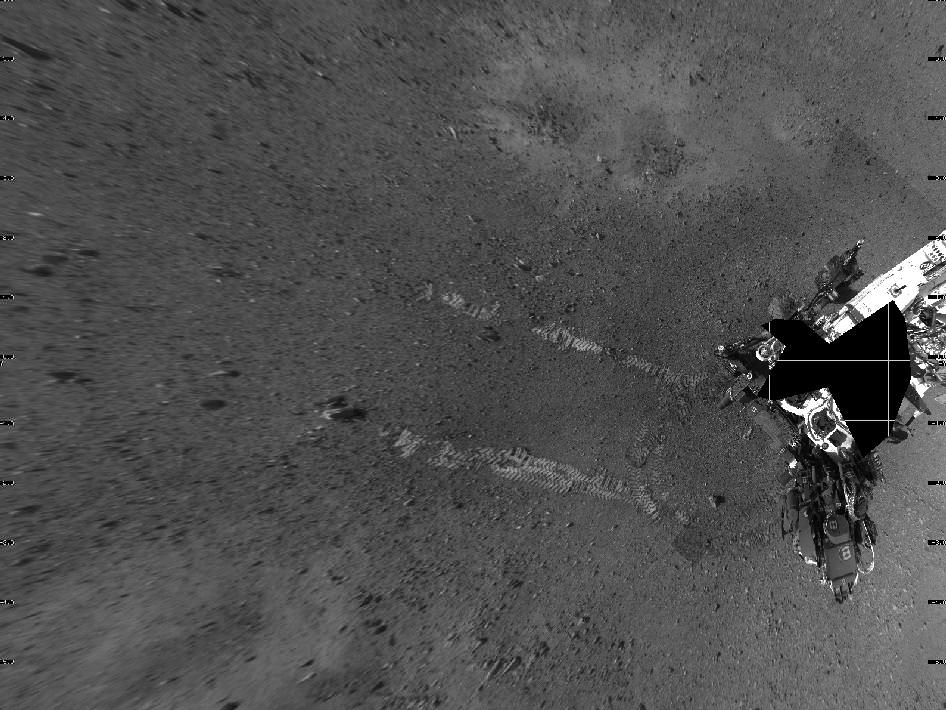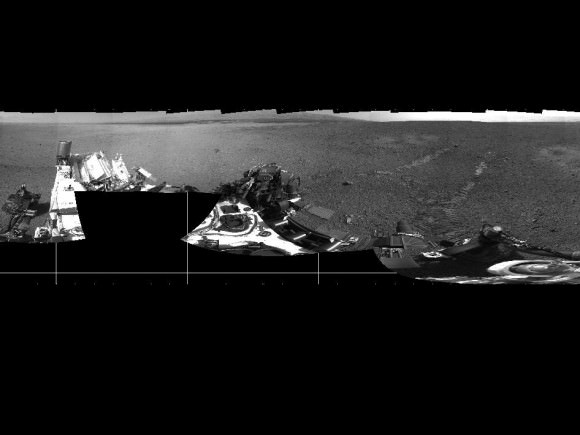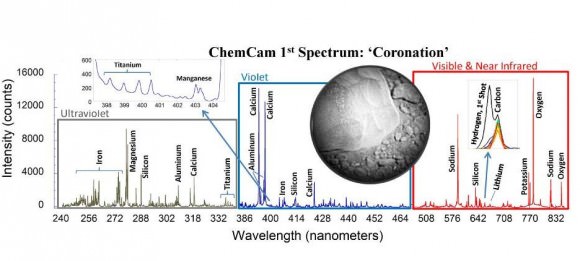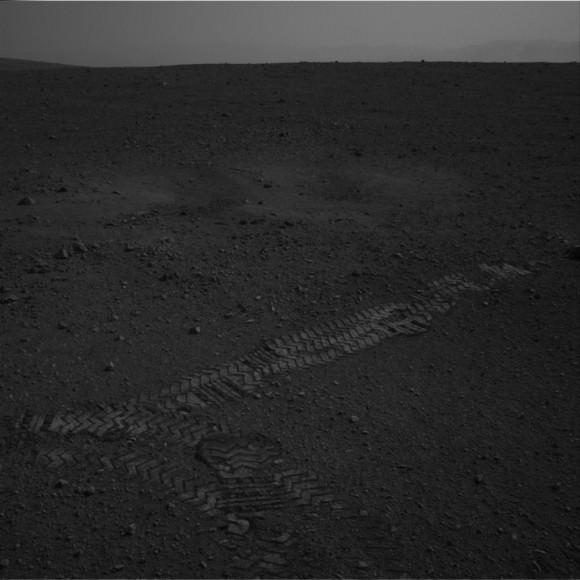An overhead view of the tracks of Curiosity’s first drive on Mars, taken by the rover’s Mastcam. Credit: NASA/JPL-Caltech
Any rover only gets one ‘first’ drive, and this historic moment has now occurred for the Curiosity Mars rover. “These are historic photos,” said rover driver Matt Heverly, “since there is only one place where your tracks start.”
“It is a really big moment,” said Curiosity Project Manager Pete Theisinger. “We built a rover. Unless the rover roves, we haven’t really accomplished anything.”
This 360-degree panorama shows evidence of a successful first test drive for NASA’s Curiosity rover. On Aug. 22, 2012, the rover made its first move, going forward about 15 feet (4.5 meters), rotating 120 degrees and then reversing about 8 feet (2.5 meters). Curiosity is about 20 feet (6 meters) from its landing site, now named Bradbury Landing. Credit: NASA/JPL-Caltech
And the place where Curiosity departed from now has a new name: Bradbury Landing, named after science fiction writer Ray Bradbury, who would have been 92 today (August 22, 2012).
“This was not a difficult choice for the science team,” said Michael Meyer, program scientist for Curiosity. “Many of us and millions of other readers were inspired in our lives by stories Ray Bradbury wrote to dream of the possibility of life on Mars.”
Curiosity’s first drive was short, but important. “We have a fully functioning mobility system,” Heverly said, adding that the key things about the drive were full revolution of the drivers in forward movement, turning, and back up, plus full revolution of drive actuators, and good data about how the rover perceives its motion. “We’re excited to have this milestone behind us,” he said, “ and it looks like we’re in a great place to do science.”
At a press conference today, Heverly showed an animation (you can see it here) derived from visualization software used for planning the first drive and said the drive took 16 minutes. But only about 4-5 minutes of that was actual driving, as most of the time was spent imaging.
Here’s a video of the team receiving the images:
Heverly said the drive took the rover forward 90 cm, then continued on for a total of 4.5 meters, then at that point took a 120 degree turn around, then backed up 2.5 meters.
The drive occurred at 14:17 UTC (10:17 EDT) today.
The first laser spectrum from the Chemistry and Camera (ChemCam) instrument on NASA’s Curiosity rover. Credit: NASA/JPL-Caltech/LANL/CNES/IRAP
Roger Wiens from the ChemCam team released the first spectrum from “Coronation,” the first rock zapped by Curiosity’s laser and analyzed by the ChemCam instrument. The plot shows emission lines from different elements present in the target, and Wiens said hydrogen showed up initially, but not in later views, meaning that there must have been hydrogen on the surface of the rock.
Weins said they’ve done some more laser shots, and received data from Goldbrun Scour, a place where the skycrane’s thruster dug in and uncovered a small rock outcrop, which appears to be bedrock, since it is layered. But all the rocks so far look to be basalts, which is not surprising, since basalts make up the majority of Mars’ surface.
Curiosity will now be taking what the team called an “intermission” of a few days to a week, where the scientists take a few days to check out the instruments and study the surroundings in more detail before doing any more driving.
“Curiosity is a much more complex vehicle than earlier Mars rovers. The testing and characterization activities during the initial weeks of the mission lay important groundwork for operating our precious national resource with appropriate care,” said Theisinger. “Sixteen days in, we are making excellent progress.”
But Theisinger also cautioned about being too triumphant about what the rover has accomplished in its short time on Mars.
“We are 16 days into a two-year mission.” he said. “We haven’t exercised our sample gathering ability, which is key. As good as it has gone, we’ve only checked off about 2 boxes of the level one requirements – launch on time and land on Mars. But the fact that we haven’t had any early problems is fantastic. But we do need to manage expectations, be prudent and not get ahead of ourselves.”
The next driving destination is an area called Glenelg, approximately 1,300 feet (400 meters) to the east-southeast, where the team can already see three different types of enticing terrain intersecting in one spot.
“When we finally get to Glenelg, we want to study the outcrop there and take a look at the context between the three different terrain types and maybe there is where we would decide to do our first drilling into rock,” said Joy Crisp, the deputy project scientist. “And after Glenelg, we head for Mount Sharp. That will be a much longer drive with probably a few brief stops along the way. That’s going to take several months before we get to that point.”
Tracks on Mars! Image Credit: NASA/JPL-Caltech





Mmmmm… Any carbon is appreciated! GO Curiosity!
“And after Glenelg, we head for Mount Sharp”.
Wow! – all that way to T?-mata-uenga only to return to Earth?..sorry, of course I meant Papa-t?-?-nuku. http://en.wikipedia.org/wiki/Mount_Sharp
And with Aeolis Mons SO close…
So, surface carbon that stick around while the hydrogen is leaving as likely water.
It doesn’t look like hydrocarbons to me, that would have been a good early catch. But at least it is promising if the minerals can contain carbon without the present oxidants leeching it all out.
At the present it is unclear to me if Curiosity can detect organics in all martian conditions. I..e can it avoid a non-detection by having heat activated oxidants breaking down organics as would have been the case for any organics Phoenix had uncovered? The detected perchlorates there were sufficient to break down trace amounts of organics.
And it is likely something similar happened to the Vikings experiments. One way to put it is: if Curiosity would have landed where Phoenix did would it make roughly the same analysis? I keep forgetting what has been said on its organics detecting capabilities.
The systems engineering team lead for the Surface Sampling and Science subsystem of Curiosity, Daniel Limonadi, is blogging on Curiosity’s sampling system over at The Planetary Society blog. He writes that the Curiosity mass spectroscopy analysis chain, which is an excellent way to characterize molecules, was mostly build 08/09, when the Phoenix results got back.
According to Limonadi, what they managed to do was to take the lessons learned from the dust clogging abilities in wet environments (say, phylosilicate clays with crystal water remaining which Curiosity may meet at the base of the crater) and install some preventive and cleaning measures for the sampling chain.
I’ll see if I can get Limonadi to comment on Curiosity’s chances to identify organics in any of its many instruments.
Mars is proving to be a mysterious planet. Everything known previously is being thrown “out the window” with new data being returned.This is one example of exploration being at its greatest. I’m damned proud we’re accomplishing it.
Daniel has replied!. And it is an excellent reply, working through all the differences in the experiment and the predicted differences in the samples, telling us what to look for and where to find it.
I think it is easiest if I C&P the reply. Since TPS blog is mashing text together, I’ll introduce paragraph breaks for readability:
The upshot is that the science and engineering team was already gearing up to make differences in the experiments that makes detecting organics easier.
And the Curiosity samples will likely have better characteristics for detection in some cases than the Phoenix samples.
This is all very exciting news! No guarantees to see organics, but at least a better chance than before. We will have to wait for the sampling to start in earnest to see how it turns out.
Meanwhile it will be interesting (at least to me) to see what the SAM wet chemistry is proposed to do. Derivitization is probably what you do with using sets of different solvents (if you look for organics; otherwise water, acids or bases may be the ticket), which complements sensitive mass spectroscopy. When they did FT-MS (Fourier transform MS) on Murchison meteorite samples using sets of complementary solvents, they were able to derive 10s of thousands of different organics.